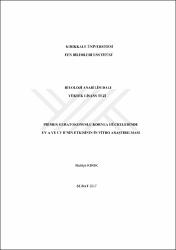| dc.contributor.advisor | Türk, Mustafa | |
| dc.contributor.author | Kırık, Rukiye | |
| dc.date.accessioned | 2021-01-16T19:12:27Z | |
| dc.date.available | 2021-01-16T19:12:27Z | |
| dc.date.issued | 2017 | |
| dc.identifier.uri | | |
| dc.identifier.uri | https://hdl.handle.net/20.500.12587/16850 | |
| dc.description | YÖK Tez ID: 459268 | en_US |
| dc.description.abstract | Keratokonus, çoğunlukla gençlerde görülen sebebi henüz bulunamamış, korneanın zayıflaması ve incelmesi ile oluşan, genetik ve çevresel etkilerin ortak sebep olduğu bir göz hastalığıdır. Korneanın epitel ve stroma hücrelerinde yüksek seviyede UV ışınlarına maruzat sebebiyle oksidatif stres yoğun olarak yaşanır. Bu hücreler güçlü bir antioksidan sisteme sahiptir. Ancak keratokonus hastalığında oksidatif hasara karşı antioksidan ve tamir mekanizmalarının bozuk olduğuna dair bulgular vardır. Güneş ışınlardaki yüksek enerjili UV ışınları gözde ciddi etkiler oluşturur. UV-C atmosferde soğurularak yeryüzüne neredeyse hiç ulaşmaz. UV-B çoğunlukla kornea epitel ve stroma hücrelerinde, UV-A ve kalan UV-B'nin de tamamı lens tarafından soğurulur. Çalışmalarımızda öncelikle keratokonuslu kornea epitel hücreleri ve normal kornea hücrelerindeki apoptoz, nekroz oranları ve sitotoksisite değerleri belirlendi. Daha sonra bu hücreler belirlenen sürelerde UV-A UV-B ışınlarına maruz bırakıldı. Apoptoz ve nekroz oranları incelendi. WST-1 (Water-Soluble Tetrazolium Salts-1) testi ile de hücre canlılığı değerleri ölçüldü. Sonuç olarak keratokonuslu kornea epitel hücrelerinin, normal kornea epitel hücrelerine göre daha çok apoptoz nekroza uğradığı ve canlılık sonuç oranlarının daha düşük olduğu gözlendi. | en_US |
| dc.description.abstract | Keratoconus, mostly seen in young people, the reason of which has not yet been found, formed by weakening and thinning of the cornea, caused by genetic and environmental influences is an eye disease. By the exposing of the UV lights effectively on the epithelial and stromal cells, high oxidative stress occurs. These cells have powerful degree of anti-oxidant system. However, in the keratoconus disease against oxidative damage, there are symptoms related with the destroyed antioxidant and repair mechanisms. High-energy UV radiation in sunlight has serious effects on cornea cells. UV-C is absorbed in the atmosphere and does not arrive hardly ever at the earth. UV-B is mostly absorbed in the corneal epithelium and stroma cells UV-A and the remaning UV-B is totally absorbed by the lenses. In our study, firstly, the epithelial cells of keratoconus corneal and the normal corneal cells, the values of the apoptosis, necrosis rates and cytotoxicity were found. Then these cells were exposed with the UV-A and UV-B radiation. It has been examined whether the deterioration in the rates of apoptosis and necrosis thenoccurred. With WST-1 test, the values of the cell viability were measured. Consequently, the keratoconus corneal epithelial cells by compared with normal corneal epithelial cells are effected more than apoptosis necrosis and the rates of viability results were found to be lower. | en_US |
| dc.language.iso | tur | en_US |
| dc.publisher | Kırıkkale Üniversitesi | en_US |
| dc.rights | info:eu-repo/semantics/openAccess | en_US |
| dc.subject | Biyoloji | en_US |
| dc.subject | Biology | en_US |
| dc.title | Primer keratokonuslu kornea hücrelerinde UV A ve UV B'nin etkisinin in vitro araştırılması | en_US |
| dc.title.alternative | I·nvestigating the in vitro efect of UV A and UV B in primer keratoconus corneal cells | en_US |
| dc.type | masterThesis | en_US |
| dc.contributor.department | KKÜ, Fen Bilimleri Enstitüsü, Biyoloji Anabilim Dalı | en_US |
| dc.identifier.startpage | 1 | en_US |
| dc.identifier.endpage | 94 | en_US |
| dc.relation.publicationcategory | Tez | en_US |
















